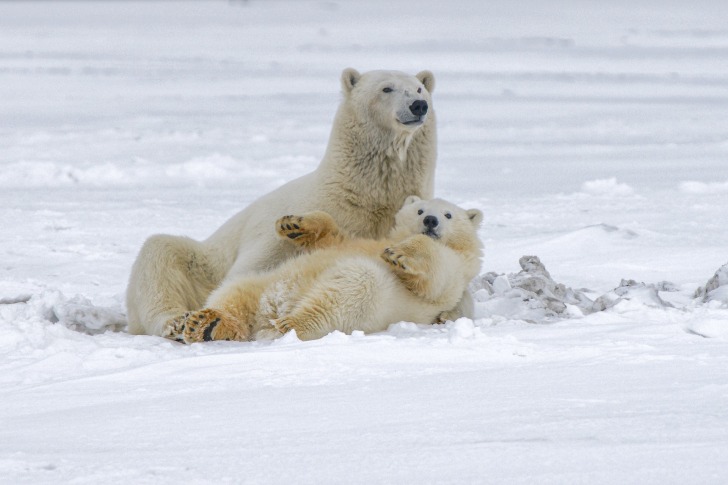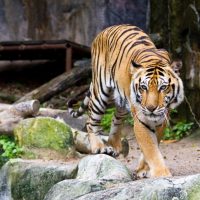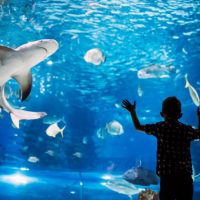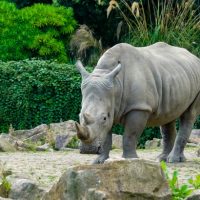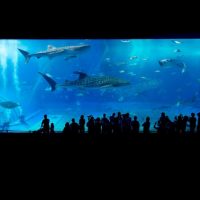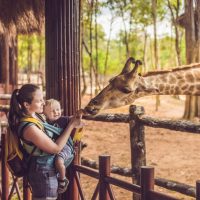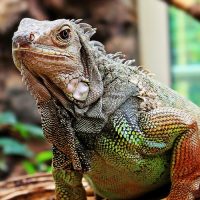Travel Alaska calls the state “one gigantic wildlife park.”
State parks in Alaska focus on nursing animals back to health and sending them back into the wild.
Contents
- 10 Best Zoos and Aquariums in Alaska
- 1. Alaska Chilkat Bald Eagle Preserve
- 2. Alaska Raptor Center
- 3. Alaska SeaLife Center
- 4. Fortress of the Bear
- 5. R.G. White Large Animal Research Station (LARS)
- 6. Sitka Sound Science Center
- 7. Alaska Wildlife Conservation Center (AWCC)
- 8. Alaska Zoo
- 9. DIPAC Macaulay Salmon Hatchery
- 10. Kodiak Laboratory Aquarium & Touch Tank
- 10 Best Zoos and Aquariums in Alaska – Summary Table
- Alaska Safety Overview
- Frequently Asked Questions
10 Best Zoos and Aquariums in Alaska
1. Alaska Chilkat Bald Eagle Preserve
Taking place only a few miles from Haines, Alaska, you can appreciate the rarity of the American Bald Eagle.
The 2022 Bald Eagle Festival in November celebrated the gathering of more than 3,000 bald eagles.
One of the best spots to see bald eagles is on the Chilkat River.
The festival that features this important U.S. symbolic bird concentrates on them when their visibility is at its highest.
You may see the Vega, Arden, and Bella Bald Eagles at the Chilkat Bald Eagle Reserve too.
At first, I thought those were names for subtypes of eagles.
However, those are actually their names, and you can sponsor them. They’re all female.
Other birds you could watch and/or sponsor include the Eurasian Eagle Owl named Hans and two Red-Tailed Hawks named Sitka and Warrior.
Hans is male, Sitka is female, and Warrior is male.
The Bald Eagle Foundation sponsors other events taking place throughout the year too, besides the Bald Eagle Festival.
For instance, school field trips and virtual tours take place here.
2. Alaska Raptor Center
National Geographic sponsors three conservation centers.
The Alaska Raptor Center is one of them, and they treat more than 200 injured birds per year.
Raptors make up most of their patient list, but they also do serve any bird in the area who needs rescuing.
In case you’re wondering what a raptor is, it’s a term often applied to predatory birds, such as bald eagles, hawks, and falcons.
Other birds that the Alaska Raptor Center serves include the Golden Eagle, the Great Horned Owl, and the Barred or Screen Owl, among others.
You can sponsor their recovery online and help maintain ideal care conditions, and you can visit the site where they’re nursed to health.
3. Alaska SeaLife Center
Most parks don’t combine a public aquarium with research, but the Alaska SeaLife Center does.
It’s dedicated to studying and educating people about aquatic animals.
What’s more, it’s the only permanent rescue center for them in the state.
This rehabilitation center is one of the three primary Alaska rescue facilities sponsored by National Geographic.
You can come to appreciate marine wildlife in person.
Animals you can see include the Stellar Sea Lion, the Ringed and Spotted Seals, and the Coho Salmon and Walleye Pollick.
You can also view King Crabs, Giant Pacific Octopuses, Green Sea Urchins, and other Crustaceans.
Birds found here include the Harlequin and Longtail Ducks, Tufted Puffin and King Elder, and several others.
If you can’t come to see the animals they feature here up close, you can participate by donating to the rescue cause.
By the way, it’s a prime location for school groups to visit.
4. Fortress of the Bear
Fortress of the Bear tells the story of bears ruling Alaska, which apparently happened before people did.
Their numbers dramatically dwindled over the centuries.
This bear fortress has eight bears living on its land that welcomes 89,000 annual visitors.
With the help of the Department of Fish & Game, they set a goal to rehabilitate bears.
Then, those animals will be released back into the wild when they’re ready to go.
For safety reasons, the closest you can get is within 25 feet of the bears you visit.
I’ve never been that close to one of these animals in my life.
For me, that’s probably near enough.
You can view the bears from a platform or indoor balcony windows.
Otherwise, there’s the option to view from windows on the ground level.
Each tour lasts about a half hour.
5. R.G. White Large Animal Research Station (LARS)
The R.G. White Large Animal Research Station (LARS) hosts field trips for schools, groups, and individuals on its 130-acre property.
Mike Yankovich turned over the farm that sits on this land to the University of Alaska Fairbanks in 1963.
Animals LARS focuses on include muskox, reindeer, and bovine.
One of their projects centers on muskox domestication.
I have seen pictures of the land that LARS owns.
It’s a mixture of forest and pasture land.
I don’t fully understand all the parameters of what this organization does.
All I know is they investigate how arctic animals adapt in what I understand to be agricultural land.
My first impression is that the grounds in Fairbanks that LARS is on are meant for a more educated crowd.
I could be wrong though.
Some people just go for the enjoyment of interacting with animals in “real life,” and that doesn’t require a college degree.
6. Sitka Sound Science Center
I’m not sure if a Haunted Aquarium is for me, but that’s one of the events the Sitka Sound Science Center hosted in October 2022.
However, the WhaleFest they hosted this past year sounds like one I would want to see.
This event happens once a year.
However, it usually has a specific theme, and the 2022 theme was “Courting, Babies, and Growth.”
Some of the education provided seems lecture oriented. However, they do have what used to be called the “Dock Walk.”
It’s now called the Underwater Marine Mammal Mashup, which teaches people how to use underwater diving gear.
That sounds like what would be my first stop, seeing how I have never been snorkeling yet.
This aquarium’s take on it is for you to see what life is like from the eyes of a marine animal.
A similar event to the Marine Mamma Mashup is the “Snorkel + Sauna.”
You’ll spend time underwater but can warm up in the sauna.
There’s also the “Marine Wildlife Cruises” that also puts you in aquatic nature.
Some of the other events are meant to support the Sitka Sound Science Center.
For instance, they have hosted a Marine Art Show and a WhaleFest Run.
The variety of events provides multiple ways for you to get involved.
7. Alaska Wildlife Conservation Center (AWCC)
The Alaska Wildlife Conservation Center in Portage, Alaska provides education on the conversation of wildlife.
This organization also actively pursues animal care and research on how to improve and maintain their ecosystems.
The AWCC takes on orphaned or injured animals.
However, they don’t nurse animals back to health and send them off.
That’s probably because the habitat on these grounds is what they prefer.
Animals you can see here include the Wood Bison, Wolf, Porcupine, and American Red Squirrel.
Others include the Elk, Fox, Deer, Coyote or Raindeer, Muskox, and Lynx.
The Great-Horned Owl also appears onsite.
8. Alaska Zoo
The Alaska Zoo in Anchorage, AK presents the white polar bear.
It’s one of the orphaned animals brought to the zoo.
He’s not in public view yet though, so that’s a bummer.
I would have wanted to go just to see him.
Biologists brought this polar bear to the zoo after spotting it in the Prudhoe Bay area.
We may not be able to see him yet, but the people in charge of him say he’s doing well.
He’s only a cub though I found out. I did, however, learn that a female polar bear is viewable to everyone.
Other animals you can see at the Alaska Zoo include the Brown and Black Bear, Mountain Goad, River Otter, Wolverine, Porcupine, and Ground Squirrel.
There are also tigers, leopards and lynxes, and both Bald and Golden Eagles.
9. DIPAC Macaulay Salmon Hatchery
In Juneau, AK, you’ll find the Douglass Island Pink and Chum (DIPAC), which features salmon fish.
I have eaten salmon, so I can’t say they’re wrong for promoting the reproduction and distribution of it.
It’s a bit mixed up because they do have an aquarium.
You can enjoy the underwater world, but keep in mind that salmon fishery is a major industry in Alaska.
There’s also a hatchery onsite that produces fish eggs.
It’s more of a corporate aquarium, but it can educate people looking to become employed in the Alaska fishing industry.
Other animals besides salmon you can see here include bears, Bald Eagles, crabs, and sea stars.
What’s more, indoor aquariums here have more than 150 species in their waters.
10. Kodiak Laboratory Aquarium & Touch Tank
I’ve noticed touch tanks have become “a thing.”
I don’t remember being able to touch animals in zoos and aquariums when I was a kid, except for the petting zoos on farms I went to.
Allowing guests to touch animals at aquariums has become more popular though.
As far as the Kodiak Laboratory, about 15,000 people visit this attraction every year.
The touch tank holds 3,500 gallons of water.
In it, you will find crabs, mollusks, sea urchins, mussels, chitons, and barnacles.
You also may spot some sea anemones close up.
10 Best Zoos and Aquariums in Alaska – Summary Table
| Zoos and Aquariums | Address |
|---|---|
| Alaska Chilkat Bald Eagle Preserve | Haines Hwy, Haines, AK 99827, USA |
| Alaska Raptor Center | 1000 Raptor Way, Sitka, AK 99835, USA |
| Alaska SeaLife Center | 301 Railway Ave, Seward, AK 99664, USA |
| Fortress of the Bear | 4639 Sawmill Creek Rd, Sitka, AK 99835, USA |
| R.G. White Large Animal Research Station (LARS) | 2220 Yankovich Rd, Fairbanks, AK 99709, USA |
| Sitka Sound Science Center | Sage Memorial Building, 834 Lincoln St, Sitka, AK 99835, USA |
| Alaska Wildlife Conservation Center (AWCC) | Mile 79, Seward Hwy, Girdwood, AK 99587, USA |
| Alaska Zoo | 4731 O'Malley Rd, Anchorage, AK 99507, USA |
| DIPAC Macaulay Salmon Hatchery | 2697 Channel Dr, Juneau, AK 99801, United States |
| Kodiak Laboratory Aquarium & Touch Tank | 301 Research Ct, Kodiak, AK 99615, USA |
Alaska Safety Overview
READ THE FULL REPORT: Alaska Safety Review
Safety Index:
- OVERALL RISK: MEDIUM
- TRANSPORT & TAXIS RISK: LOW
- PICKPOCKETS RISK: LOW
- NATURAL DISASTERS RISK: MEDIUM
- MUGGING RISK: HIGH
- TERRORISM RISK: LOW
- SCAMS RISK: MEDIUM
- WOMEN TRAVELERS RISK: LOW
Frequently Asked Questions
Do Alaska zoos have polar bears?
The best place to see polar bears is the Alaska Zoo.
Right now, it has one female polar bear that is viewable to the public and a male cub that the public hasn’t seen yet.
They used to have two more polar bears, but they, unfortunately, passed away a few years from 2022.
What is the best zoo in Alaska?
As far as the “best” zoo, that’s subjective.
One of the most popular is the Alaska Wildlife Conservation Centre.
Another is the Alaska Rainforest Sanctuary Wildlife & Eagle Centre.
What animals can you see at Alaska zoos?
Depending on the location, you will see brown and black bears, polar bears, eagles, wolves, harbor seals, Snow Leopards, Canadian Lynxes, and more.
What is the largest zoo in Alaska?
The Alaska Wildlife Conservation Centre has 200 acres of land.
However, the Alaska Zoo features primarily Arctic animals, making it one of the most unique zoos in the state.
What is the average Alaska temperature?
This will help you decide when you’d most feel comfortable about viewing Alaska zoos and aquariums.
Summer temperatures typically range from 45-75 degrees F in summer.
In winter, they range from 20 to -10 degrees F.
Alaska does sometimes experience extremes of about 90 degrees F in the summer or -60 F in the winter.
These facts about Alaska’s climate refute the idea that there are always subzero temperatures around here.
This gives you choices of when you’d prefer to visit the state and experience its wildlife firsthand.
